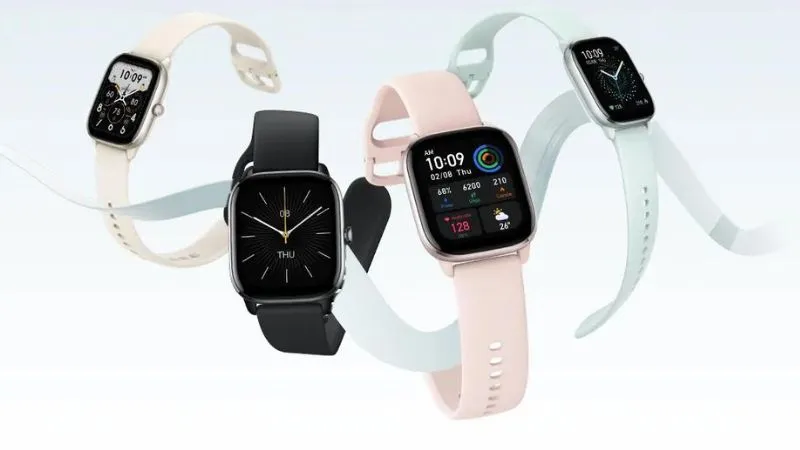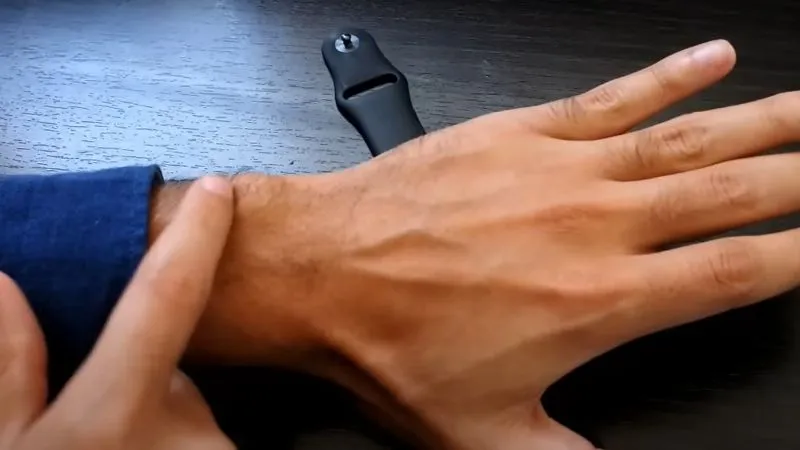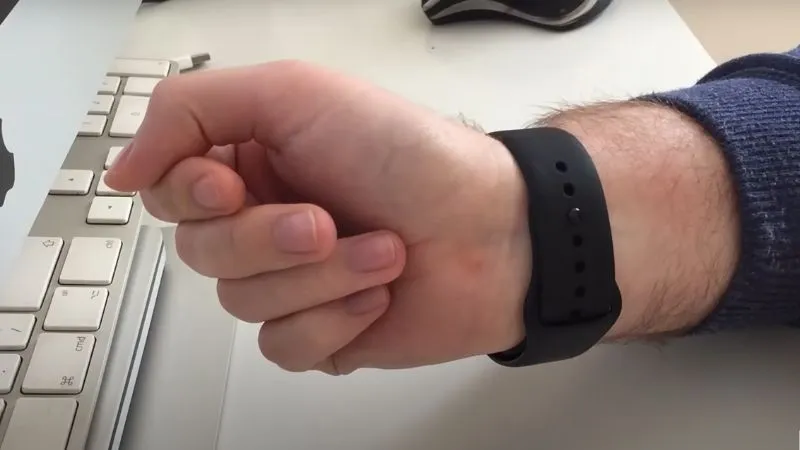How to Wear a Smartwatch Properly? Don’t Make These Mistakes!
If you have just purchased your first smartwatch and now you want to know the correct way to wear it, then this is the only guide you need to read.
In this guide, I am going to explain the right way to wear a smartwatch.
So, let’s get started.
How to Wear a Smartwatch Properly?
Wearing a smartwatch is not rocket science, but there are a few things you need to consider that will ensure your comfort throughout the day.
And here they are:
1. Choose the Right Smartwatch

The first thing you need to keep in mind is that you have to choose the right smartwatch.
Let’s imagine: you have a very small hand but choose a smartwatch with a big display.
Would you be comfortable wearing it?
No.
Because you have chosen the wrong type of smartwatch.
In that case, you should have chosen a small-sized smartwatch that fits correctly on your thin hand.
By the way, if you’re interested, here are the best smartwatches for small hands and the best smartwatches for big hands, but let’s focus on the main point.
I have already published an in-depth guide on how to choose the right smartwatch.
However, for your convenience, I’m going to highlight some important points here.
- Design and Style: Consider the design, size, and aesthetics of the smartwatch to match your personal style (e.g., round smartwatches, square smartwatches)
- Display: Look for a clear, easy-to-read display that suits your preferences (e.g., AMOLED smartwatches).
- Battery Life: Consider the battery life and choose a smartwatch that meets your usage needs (e.g., best battery life smartwatches).
- Features: Identify the features you need, such as BT calling, heart rate monitoring, GPS, or fitness tracking (e.g., BT calling smartwatches).
- Water Resistance: If you plan to use the smartwatch during water-related activities, choose one with adequate water resistance (e.g., waterproof smartwatches).
- Budget: Set a budget and choose a smartwatch that offers the best value for your money (e.g., smartwatches under 2000).
When you consider these factors, you will have a clear mindset regarding which smartwatch will be perfect for you.
2. Choose the Right Strap

This is the most common practice to ensure comfort while wearing a smartwatch throughout the day. However, it is often overlooked by many people.
Trust me, if you haven’t chosen the right strap for your smartwatch, you will likely regret it.
For instance, if you have long hair on your hand and you choose a metal strap, it is probably the wrong decision.
Hair tends to get stuck in the metal strap, causing pain and irritation.
Similarly, if you have allergies to leather and you choose a leather strap, it can worsen your health.
That’s why it’s crucial to always choose the appropriate strap.
If you have any doubts or confusion, here is a simple guide to help you with that.
- Material: Consider different strap materials like silicone, leather, metal, or fabric, based on your comfort and style preferences.
- Comfort: Look for straps that are comfortable to wear for extended periods, with features like adjustable length and breathable materials.
- Size and Compatibility: Ensure the strap is compatible with your specific smartwatch model and fits securely.
- Style and Aesthetics: Choose a strap that complements your personal style and enhances the overall look of your smartwatch.
- Durability: Opt for straps that are durable and can withstand daily wear and tear.
- Closure Mechanism: Consider different closure options like buckles, magnetic closures, or quick-release mechanisms for convenience and security.
- Water Resistance: If you engage in water-related activities, select straps that are water-resistant or suitable for swimming.
By considering these factors, you’ll be able to choose the right smartwatch strap that not only enhances your comfort but also complements your personal style, making your smartwatch truly unique.
3. Wear Smartwatch On Your Non-dominant Hand

Now, let’s delve deeper into why I strongly emphasize this point.
When you opt to wear a smartwatch on your dominant hand and engage in various activities throughout the day, the likelihood of your smartwatch sustaining damage and acquiring unsightly scratches increases significantly.
Imagine this scenario: you’re actively using your dominant hand to tackle tasks, such as typing on a keyboard, cooking, or engaging in sports.
With each movement, there’s a higher chance of accidentally scraping or banging your smartwatch against a hard surface.
These unfortunate encounters can result in unpleasant scratches or even more severe damage to your beloved device.
Prevention is key, and adopting the habit of wearing your smartwatch on your non-dominant hand is a wise exercise to mitigate the risk of damage.
By wearing your smartwatch on your non-dominant hand, you create a buffer zone, shielding it from direct impact during your daily routines.
This simple adjustment can go a long way in preserving the longevity and visual appeal of your smartwatch, ensuring that it remains an elegant and functional companion on your wrist.
Remember, taking proactive measures to protect your smartwatch from scratches is essential, and adopting the habit of wearing it on your non-dominant hand is a small change that can yield significant benefits.
4. Positioning on the Wrist

Now, this is the most crucial step in properly wearing a smartwatch.
I have noticed that most people wear their smartwatches higher up on the wrist bone.
But let me tell you something: it’s a wrong practice.
Why? Because in this position, your hand’s movement is restricted.
Your smartwatch becomes a barrier to the free movement of your hand.
So what you need to do is move your smartwatch slightly down from the wrist bone, leaving about a finger’s space, and that is the perfect position for your smartwatch.
However, is this position also suitable when you’re working out?
I believe not.
During your fitness activities, your hands undergo extensive movements that are not typical in your daily life.
That’s why it’s best to move your smartwatch even further down to provide your hand with even more freedom of movement.
5. Adjusting the Band

Now that you have positioned the smartwatch correctly, it’s time to adjust its strap to find that sweet spot of comfort.
Start by loosening the strap a bit and gently slide your smartwatch onto your wrist.
You want it to sit snugly, but not too tight.
If it’s leaving marks or cutting off your circulation, it’s definitely too tight, and that’s a big no-no.
On the other hand, if it’s sliding up and down your arm like a mischievous watermelon seed, it’s too loose.
Aim for a fit that allows the smartwatch to stay in place, yet doesn’t make you feel like you’re in handcuffs.
Now that you’ve found the right fit, let’s make sure your smartwatch stays put throughout the day.
Many smartwatch straps come with adjustable buckles or clasps, so take advantage of those nifty little features.
Secure the buckle or clasp tightly, but not too tight – you don’t want it digging into your skin or causing discomfort.
A well-secured smartwatch ensures that it won’t go rogue during your morning run or fancy dinner party.
Plus, you’ll avoid the uncomfortable feeling of panic when you notice your wrist feels empty without the smartwatch.
Remember, a properly fitted smartwatch should feel like an extension of your arm, not an unwelcome visitor.
So take a few moments to find that perfect comfort zone and enjoy the seamless experience your smartwatch has to offer.
How to Wear a Smartwatch for Accurate Monitoring
When it comes to wearing a smartwatch for accurate monitoring, there’s a little-known secret that can make all the difference.
It’s all about finding the optimal position on your wrist, specifically the soft part.
So, let’s dive in and uncover this hidden gem of wearable technology wisdom.
1. The Soft Part
The soft part of your wrist, located on the side opposite to your hand, is an ideal spot to position your smartwatch for accurate monitoring.
Why, you ask?
Well, this area is less affected by external factors such as bone density and muscle movement, making it a prime location for sensors to pick up accurate data.
By placing your smartwatch behind the wrist, you’re ensuring a closer proximity to important blood vessels and veins, which play a crucial role in gathering vital health metrics.
2. Optimal Sensor Contact
Now that we understand the importance of the soft part, let’s talk about sensor contact.
When you wear your smartwatch behind the wrist, the sensors on the underside of the smartwatch have a better chance of establishing direct contact with your skin.
This direct contact enhances the accuracy of measurements like heart rate monitoring, blood oxygen level tracking, and other health-related metrics.
It minimizes interference caused by ambient light, external movements, and even sweat, ensuring that the smartwatch captures the most precise data possible.
3. Strap Adjustments
To maximize the accuracy of your smartwatch monitoring, it’s essential to ensure a snug and secure fit.
Adjust the strap of your smartwatch to achieve a comfortable yet tight fit, preventing any slippage or movement during activities.
Remember, a properly adjusted strap not only helps maintain accuracy but also keeps the sensors in optimal contact with your skin.
So, next time you put on your smartwatch, remember the secret lies in wearing it behind the wrist, specifically on the soft part.
By doing so, you’ll unlock the full potential of accurate monitoring, enjoy enhanced comfort, and make the most of your wearable technology companion.
Drawbacks of Wearing Smartwatch Incorrectly
Wearing a smartwatch incorrectly can have a few drawbacks that can impact both your comfort and the functionality of the smartwatch.
And here are some of the common drawbacks:
1. Inaccurate Monitoring
One of the primary drawbacks of wearing a smartwatch incorrectly is compromised accuracy in monitoring features.
When the smartwatch is not positioned properly on your wrist, such as being too loose or worn on the wrong part, the smartwatch sensors may not have optimal contact with your skin.
This can lead to inaccurate readings for metrics like heart rate, blood oxygen levels, and sleep tracking.
Inaccurate monitoring defeats the purpose of using a smartwatch to track and analyze your health and fitness data effectively.
2. Discomfort and Irritation
Wearing a smartwatch incorrectly can result in discomfort and irritation.
If the strap is too tight, it can cause discomfort, restrict blood flow, and leave marks on your skin.
On the other hand, if the strap is too loose, the smartwatch may move around excessively, leading to irritation and potentially causing the sensors to lose contact with your skin.
Discomfort and irritation can make it difficult to wear the smartwatch for extended periods, defeating the purpose of having a wearable gadget that you can comfortably use throughout the day.
3. Reduced Durability
Wearing a smartwatch incorrectly can also impact its durability.
If the smartwatch is not securely fastened or positioned on your wrist, it becomes more prone to accidental knocks, falls, or damage.
Additionally, improper placement may expose the watch to excessive moisture or impact during physical activities, potentially leading to water damage or other issues.
By wearing the smartwatch correctly, you can minimize the risk of accidental damage and ensure its longevity.
4. Limited Functionality
Wearing a smartwatch incorrectly can limit its functionality and convenience.
For example, if the dial is not positioned properly on the top of your wrist, it may become difficult to read notifications, interact with the touchscreen, or access the smartwatch’s features easily.
This can be particularly inconvenient during busy or active moments when you need quick and effortless access to the smartwatch’s capabilities.
The Bottom Line
So there you have it! The proper way to wear a smartwatch.
However, I’m not saying that this is the only way to get a proper fit of your smartwatch but I bet, this way, you cannot have any complaint of wearing a smartwatch.
I can say that this is the most comfortable way to wear your smartwatch throughout the day.
Apart from this, I also write a few guides for you, give them a read.
- What is DND mode in smartwatch
- Which display is best for smartwatch
- Do smartwatches work without phone
Frequently Asked Questions
Can a smartwatch be worn on the inside of the wrist?
Yes, a smartwatch can be worn on the inside of the wrist, but it is less common and may have some drawbacks.
What is the correct way to wear an Apple Watch band?
To wear an Apple Watch band correctly, follow these steps:
1. Hold the Apple Watch with the display facing upward.
2. Position the band so that the narrow end attaches to the top of the watch, and the wider end attaches to the bottom.
3. Slide the band’s lugs into the corresponding slots on the watch, ensuring a secure fit.
4. Tighten or loosen the band as needed to achieve a comfortable fit.
5. Make sure the band is securely fastened to prevent the watch from slipping or moving excessively during use.
Is it okay to wear a smartwatch all day?
Yes, it is generally okay to wear a smartwatch all day. Smartwatches are designed to be worn for extended periods, and many people find them useful for tracking various aspects of their daily lives. However, it’s important to listen to your body and take breaks if you experience discomfort or notice any skin irritation.
Where is the proper place to wear a smartwatch?
The proper place to wear a smartwatch is typically on the outside of the wrist, with the watch face positioned on the top side of the wrist. This placement offers better visibility of the screen and ease of interaction with the smartwatch’s features. Wearing the smartwatch on the soft part of the wrist, opposite the hand, allows for optimal sensor contact and reliable monitoring. However, personal comfort and preferences may vary, so finding the right position that works for you is important.